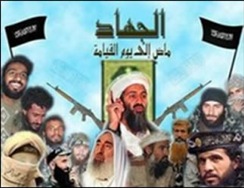
The figure of Usama bin Ladin appears at the epicenter of this image, in front of a Qur’an and under the slogan: “al-jihad madin ila yawm al-qiyama” (“Jihad continues until the day of resurrection.”). The leaders of other jihadi groups are also pictured, including Khattab and Abu Sa‘id al-Qurtasha’I, of the Chechan Islamic International Peacekeeping Brigade (also known as Mezhdunarodnaya Mirotvorcheskaya Brigada), and Ahmad Yasin of Hamas.
Religious leaders are seen as pious individuals who possess proper religious training and credentials, and thus are considered the chief religious ideologues of the jihadi movement. Their firebrand sermons and writings, distributed throughout the Muslim world, are key motivational tools used for recruiting and inspiring jihadi activists. It is therefore not surprising that such leaders are common motifs in jihadi imagery and are used as symbols of the religious piety espoused by the jihadi movement. Their images serve to religiously legitimize jihadi groups and promote activism along purely Islamic lines. As a strategic leader, the figure serves as an example of someone who is both a religiously pious individual and a militarily successful jihadi commander doing God’s work.
According to prophetic tradition (hadith), the black flag was the battle flag of the Prophet Muhammad and it was carried into battle by many of his companions. In the contemporary Islamist movement, the black flag with the shahada (Islamic testimony of faith holding that there is no god but Allah and that Muhammad is his messenger) or takbir (the words “Allahu Akbar” or “God is great”) is used to evoke notions of jihad and of reestablishing the Islamic Caliphate.
 Skip to content
Skip to content
